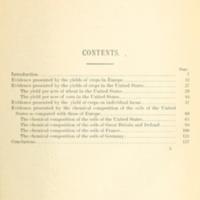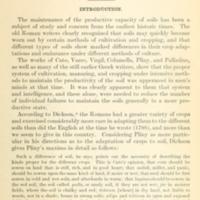A Study of Crop Yields and Soil Composition in Relation to Soil Productivity
Creator
Date
1909
Subject
Excerpt
A careful study of the data which have been presented appears to justify two conclusions.
First. That the productivity of the newer agricultural soils of the United States and of the older agricultural soils of Europe, taken as a whole and for a nation, are not declining, as is popularly supposed. Individual farms deteriorate and soils wear out as they have always done, but as a whole it seems probable that we are producing more crops per acre than formerly. This is undoubtedly due to many factors; to better and more intelligent cultivation, more and better systems of rotation of crops, and, in later years, to intelligent use of fertilizers — three methods of control in the hands of every individual farmer. In addition, we must recognize the increase in farm animals and stock, the improvement in seed by selection and breeding, and the increasing density in population, which is forcing attention to more intensive methods.
Second. That so far as our information goes there is apparently no significant difference at the present time between the composition of the older agricultural soils of Europe and the newer agricultural soils of the United States with respect to potash, phosphoric acid, lime, and magnesia.
First. That the productivity of the newer agricultural soils of the United States and of the older agricultural soils of Europe, taken as a whole and for a nation, are not declining, as is popularly supposed. Individual farms deteriorate and soils wear out as they have always done, but as a whole it seems probable that we are producing more crops per acre than formerly. This is undoubtedly due to many factors; to better and more intelligent cultivation, more and better systems of rotation of crops, and, in later years, to intelligent use of fertilizers — three methods of control in the hands of every individual farmer. In addition, we must recognize the increase in farm animals and stock, the improvement in seed by selection and breeding, and the increasing density in population, which is forcing attention to more intensive methods.
Second. That so far as our information goes there is apparently no significant difference at the present time between the composition of the older agricultural soils of Europe and the newer agricultural soils of the United States with respect to potash, phosphoric acid, lime, and magnesia.
Title
A Study of Crop Yields and Soil Composition in Relation to Soil Productivity
File(s)
A Study of Crop Yields Cover.jpg
(image/jpeg)
A Study of Crop Yields TOC.jpg
(image/jpeg)
A Study of Crop Yields 1.jpg
(image/jpeg)
 An official website of the United States government.
An official website of the United States government.




